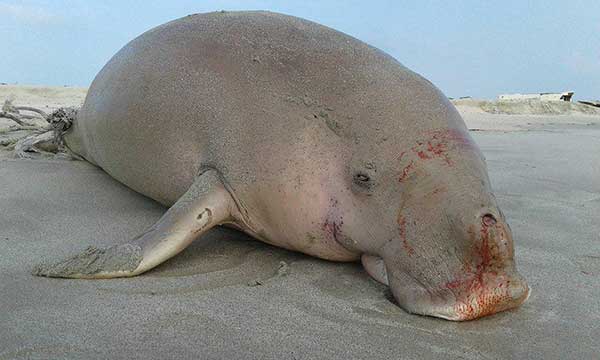 |
|
The remains of a dugong, the apparent victim of dynamiting. Sri Lanka's Wildlife Conservation Department. |
The reclusive dugong, the animal that seems to be everyone's friend, is falling victim to poor fishing practices
Channa Suraweera was shocked when the picture of a dead dugong jumped into his eyes for the first time.
Seeing the thick red vestige under its nose indicated how blood would have spurted through its nostrils, says Suraweera, an officer with the Wildlife Conservation Department in Sri Lanka.
"It must have been an extremely painful death. Three dugong deaths have been reported since the beginning of this year, all by Sri Lankan Navy."
The dugong, a medium-sized marine mammal, can be seen in aquariums around the world, their chubby face, gentle eyes and what seems like a permanent smile endearing them to millions. However, outside the haven that aquariums offer, in many waters that the creature used to call home dugongs have been hunted down to extinction or near extinction.
The waters of Sri Lanka are no exception, including the Gulf of Mannar, a large shallow bay between the southeastern tip of India and the west coast of Sri Lanka.
"Every two months or so we lose an animal," says Arjan Rajasuriya, of the International Union for Conservation of Nature. Since January 2015, Rajasuriya, who is based in Sri Lanka, has been part of a project in which the United Nations Environment Program teams up with regional and international NGOs and the Sri Lankan government in an effort to protect the endangered species.
But if the dugong is to be protected properly a lot more needs to be learned about the animal, which is notorious for its reclusiveness.
Among the main goals of the program, known as the Dugong and Seagrass Conservation Project, is to map sea grass meadows, the sole habitat and source of food for the vegetarian marine mammal that lives in the shallow seawater off the coast.
"The dugong subsists on sea grass - no sea grass, no dugong," says Rajasuriya, who has been involved in protecting Sri Lanka's coast for more than 30 years and yet, astonishingly, has never seen a live dugong in the region.
"On the other hand, the existence of large patches of sea grass meadow, especially those with grazing signs, could be a strong indicator that there are dugongs around.
|
|
|
|
|
|
|
|
